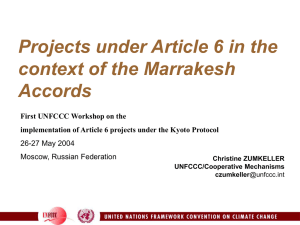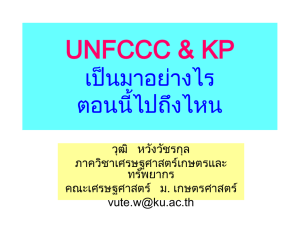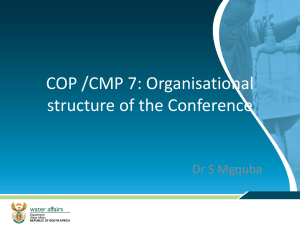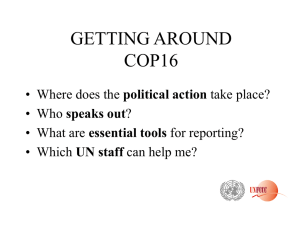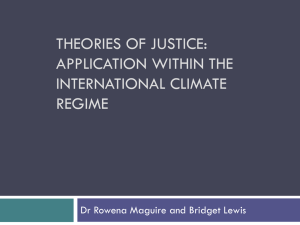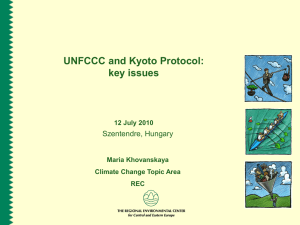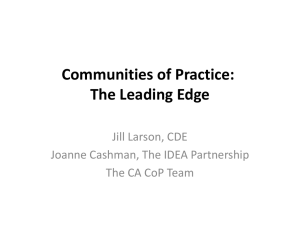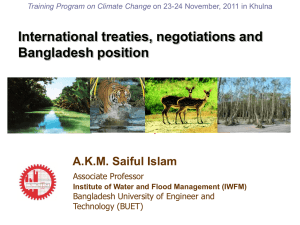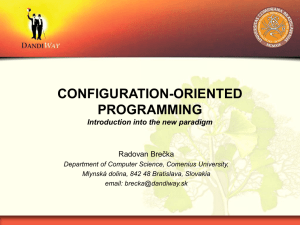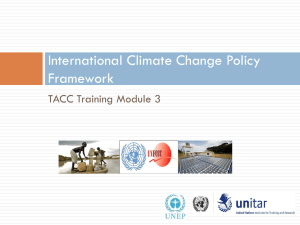Investor Momentum Building for Climate Action
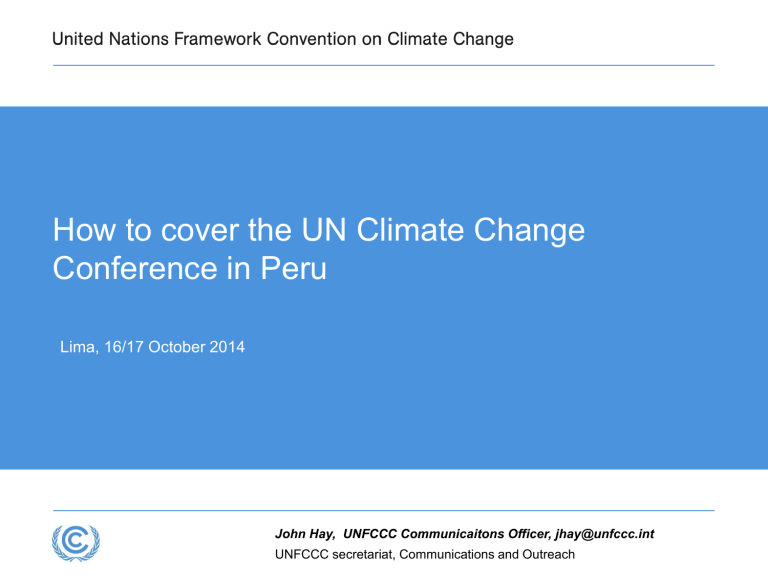
How to cover the UN Climate Change
Conference in Peru
Lima, 16/17 October 2014
John Hay, UNFCCC Communicaitons Officer, jhay@unfccc.int
UNFCCC secretariat, Communications and Outreach
Overview
• How is global momentum for climate action building?
• What is the UNFCCC and its Kyoto Protocol?
• Which key agreements will you hear most about?
• What are the key deliverables for COP 20?
• Where does the political action take place?
• Who meets where?
• Who keeps an eye on things?
• Who speaks out?
• What are essential tools for reporting?
• How is the UN celebrating climate action?
• What are the key UN contacts?
How is global momentum for change building?
City and Popular Momentum Building for
Climate Action
How is global momentum for change building?
Investor Momentum Building for Climate
Action
How is global momentum for change building?
Business Momentum Building for Climate
Action
How is global momentum for change building?
Government Momentum Building for Climate
Action
The UNFCCC – What is it?
The UN Framework Convention on Climate
Change:
• 196 Parties (195 countries + EU) = near universal membership
• The ultimate objective of the Convention:
“… stabilization of greenhouse gas concentrations in the atmosphere at a level that would prevent dangerous anthropogenic interference with the climate system.” (Art. 2)
• Annual meetings of all Parties at the Conference of the Parties
(COP) to take decisions
The Kyoto Protocol - What is it?
The Kyoto Protocol:
193 Parties (192 countries + EU)
1 st commitment period: 2008 – 2012
2 nd commitment period 2013 - 2020
Main Features:
• Legally binding targets for emissions of greenhouse gases in industrialized countries
• International market-based mechanisms creating a new commodity: carbon (emissions trading, CDM)
• Valuable architecture , but scope not commensurate with problem
Other agreements you need to know about
Three important agreements you’ll hear a lot about:
• Cancun Agreements (2010)
• Doha Amendment (2012)
• Paris 2015 Universal change agreement (to enter into effect in 2020)
Cancun agreements
NEW INSTITUTIONS that emerged from Cancun in
2010 and are now up and running:
1) Green Climate Fund
A tool to mobilize 100 billion USD annually by 2020, both for adaptation and mitigation, in developing countries
2) Technology Mechanism
with Technology Committee and Climate Technology Centre and Network – technology for mitigation and adaptation
3) Adaptation Framework + Committee
To coordinate adaptation action in developing countries
Doha Amendment
18 countries ratified to date. Doha Amendment enter Enters into force only once 144 Parties have ratified.
2015 Paris agreement
T he Paris 2015 agreement…
• needs to chart a low carbon and resilient course over 20 – 30 years (covering mitigation and adaptation in equal parts)
• Needs to be universal , and ensure finance and technology to developing countries
• must ensure that 90 trillion of investments over next 15 years go into right direction (Global Commission on the Economy and
Climate)
• be a platform for collaboration on climate change
• must ensure climate neutrality in the second half of the century
(=crucial to staying below a maximum 2 degrees Celsius temperature rise)
Key Deliverables for COP 21
Key Deliverables for COP 21
• A coherent Paris 2015 text by the end of the conference (must be available in 6 UN languages in May 2015!)
• Decision on nature of Intended Nationally Determined
Contributions (INDCs to be submitted by April 2015!)
• Decision on Technical Expert Meetings (2014 focus on cities, land use, agriculture, renewable energy, energy efficiency, CCSU, non-CO2 gases)
What is negotiated where?
CENTRAL STAGES OF THE COP: PLENARIES
What is negotiated where?
• UNFCC Negotiating Bodies
• COP (Conference of the Parties – 195 countries + EU)
• COP/CMP (COP serving as meeting to the Kyoto Protocol -193 countries +EU)
• ADP (Ad Hoc Working Group on the Durban Platform for Enhanced Action , founded 2011, 196 Parties)
• AWG-KP (Ad Hoc Working Group on Further Commitments for Annex I Parties under the Kyoto Protocol, founded 2005, 193 Parties)
• SBSTA (Subsidiary Body for Scientific and Technological Advice)
• SBI (Subsidiary Body for Implementation)
Who negotiates? Developing countries
PARTY NEGOTIATING GROUPS Non-Annex 1
• G77 and China (135 countries) Presidency in 2014: Nauru
• BASIC: China, India, Brazil, South Africa
• GRULAC: (Latin American and Caribbean Group, 33 countries)
• African Group (53 countries)
• LDCs (Least Developed Countries) 49 countries
• AOSIS (Alliance of Small Island States, 43 countries)
• ALBA group : Cuba, Venezuela, Ecuador, Bolivia, Nicaragua
Who speaks for whom? – developed countries
PARTY NEGOTIATING GROUPS – Annex 1 and combined
• Umbrella group : US, Russia, Ukraine Canada, Japan, New
Zealand, Australia
• EU : European Union, 28 countries
• Environmental Integrity Group : Switzerland + Mexico and
South Korea (both OECD)
• Cartagena Dialogue: around 40 countries including Peru,
Mexico, Chile, Colombia, Costa Rica, Panama, Antigua &
Barbuda, EU, Ethiopia.
Who keeps an eye on things?
WATCHING CLOSELY…
Who keeps an eye on things?
…ON BEHALF OF THE PUBLIC…
Who keeps an eye on things?
CIVIL SOCIETY AND OBSERVERS
• Around 1800 accredited to the UNFCCC
• Engos, Ringos, Bingos, Indigenous Peoples, Youngos, trade unions, faith groups, UN agencies
• Make up around 50% of all participants
• Play very important role as observers and experts – but governments decide
Who keeps an eye on things?
Public highly engaged via social media
Who meets where?
WHO MEETS WHERE (AND WHAT IS ACCESSIBLE)?
• Opening ceremonies and plenary (open via CCTV, for pool)
• Side events > 200 (open)
• Happenings (e.g. fossil of the day award)
• Contact groups (not open)
• “ Meetings ”, including bilaterals (not open)
Who sums up events for the press?
SUMMING UP KEY DEVELOPMENTS AND
OUTCOMES …
Who briefs the press
KEY VOICES
• UNFCCC Executive Secretary
• Peruvian COP President
• The UN Secretary General
• Delegations: EU, USA,G77 and China, African Group etc.
• CAN (>500 NGOs) + other NGOs
• UN orgs: WMO, IPCC, UNEP, UNDP etc
COP 20 Highlights
COP 20 HIGHLIGHTS
• 1 December: Grand opening , from 10:00 a.m.
• 6-7 December; Business events (e.g. Caring for Climate)
• 9 December 10:00 a.m: opening of High Level Segment with
UNSG, more than 100 Ministers, all of whom give speeches
• 10 December Momentum for Change showcase event (8:30 -
20:00)
• 12/13 Dec: Closing plenary: sleepless in Lima !
What is written where?
OTHER KEY SOURCES OF INFORMATION
• Daily programme (UNFCCC)
• CCTV Monitors
• Live web cast <unfccc.int>
• iPhone App “COP 20 Navigator” + Android Host Government App
• UNFCCC and Host Government websites
• Twitter (+ Twitter Wall): @UN_climatetalks, @LimaCOP20,
@manupulgarvidal, @CFigueres
• Key NGO publication ECO (Climate Action Network)
Celebrating Climate Action
UNFCCC’s MOMENTUM FOR CHANGE INITIATIVE
LIGHTHOUSE ACTIVITIES
• Shining examples of transformational climate action happening around the world
• Focus on urban poor, climate finance, women, ICTs
• Both small and large initiatives are showcased
Key reports in the run up to COP 20
Key reports in run-up to COP 20
• 2 November IPCC Synthesis Report (= Climate Change is here and is accelerating; we can still prevent the worst)
• 6 November UNEP update of Emissions Gap Report (we have the technical and political means to stay below a maximum two degrees rise)
• World Bank update Feeling the Heat Report ( = we are heading towards 4 degrees Celsius temperature rise under biz as usual)
Other key sources of information
WHO CAN HELP ME FROM THE UN?
• General UNFCCC press account: press@unfccc.int
• UNIC: Christian Sanchez, christian.sanchez@unic.org
(+ Carlos
Jimenez)
• Cubical bookings in media center davis.tim52@gmail.com
• Momentum for Change: smarchildon@unfccc.int
• Media for UN agencies apart from UNFCCC: Dan Shepard, shepard@un.org
+ Media counter at the COP
Good luck!
